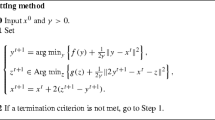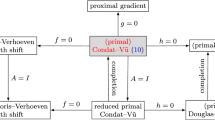Abstract
We propose a new first-order splitting algorithm for solving jointly the primal and dual formulations of large-scale convex minimization problems involving the sum of a smooth function with Lipschitzian gradient, a nonsmooth proximable function, and linear composite functions. This is a full splitting approach, in the sense that the gradient and the linear operators involved are applied explicitly without any inversion, while the nonsmooth functions are processed individually via their proximity operators. This work brings together and notably extends several classical splitting schemes, like the forward–backward and Douglas–Rachford methods, as well as the recent primal–dual method of Chambolle and Pock designed for problems with linear composite terms.
Similar content being viewed by others
References
Sidky, E.Y., Jørgensen, J.H., Pan, X.: Convex optimization problem prototyping for image reconstruction in computed tomography with the Chambolle–Pock algorithm. Phys. Med. Biol. 57(10), 3065–3091 (2012)
Mercier, B.: Topics in Finite Element Solution of Elliptic Problems. Lectures on Mathematics, vol. 63. Tata Institute of Fundamental Research, Bombay (1979)
Lions, P.L., Mercier, B.: Splitting algorithms for the sum of two nonlinear operators. SIAM J. Numer. Anal. 16(6), 964–979 (1979)
Passty, G.B.: Ergodic convergence to a zero of the sum of monotone operators in Hilbert space. J. Math. Anal. Appl. 72, 383–390 (1979)
Eckstein, J.: Splitting methods for monotone operators with applications to parallel optimization. Ph.D. Thesis, MIT, Cambridge, MA (1989)
Eckstein, J., Bertsekas, D.P.: On the Douglas–Rachford splitting method and the proximal point algorithm for maximal monotone operators. Math. Program. 55, 293–318 (1992)
Combettes, P.: Solving monotone inclusions via compositions of nonexpansive averaged operators. Optimization 53(5–6), 475–504 (2004)
Moreau, J.J.: Fonctions convexes duales et points proximaux dans un espace hilbertien. C. R. Math. Acad. Sci. 255, 2897–2899 (1962)
Combettes, P.L., Pesquet, J.C.: Proximal splitting methods in signal processing. In: Bauschke, H.H., Burachik, R., Combettes, P.L., Elser, V., Luke, D.R., Wolkowicz, H. (eds.) Fixed-Point Algorithms for Inverse Problems in Science and Engineering. Springer, New York (2010)
Goldstein, T., Osher, S.: The split Bregman method for L1-regularized problems. SIAM J. Imaging Sci. 2(2), 323–343 (2009)
Chambolle, A., Caselles, V., Cremers, D., Novaga, M., Pock, T.: An introduction to total variation for image analysis. In: Theoretical Foundations and Numerical Methods for Sparse Recovery. Radon Series Comp. Appl. Math, vol. 9, pp. 263–340. de Gruyter, Berlin (2010)
Becker, S., Candès, E., Grant, M.: Templates for convex cone problems with applications to sparse signal recovery. Math. Program. Comput. 3(3), 165–218 (2011)
Monteiro, R.D.C., Svaiter, B.F.: Iteration-complexity of block-decomposition algorithms and the alternating minimization augmented Lagrangian method (2010). Preprint, submitted to Math. Program.
Chambolle, A., Pock, T.: A first-order primal–dual algorithm for convex problems with applications to imaging. J. Math. Imaging Vis. 40(1), 120–145 (2011)
Esser, E., Zhang, X., Chan, T.: A general framework for a class of first order primal–dual algorithms for convex optimization in imaging science. SIAM J. Imaging Sci. 3(4), 1015–1046 (2010)
Zhang, X., Burger, M., Osher, S.: A unified primal-dual algorithm framework based on Bregman iteration. J. Sci. Comput. 46(1), 20–46 (2010)
He, B.S., Yuan, X.M.: Convergence analysis of primal–dual algorithms for a saddle-point problem: from contraction perspective. SIAM J. Imaging Sci. 5, 119–149 (2012)
Pesquet, J.C., Pustelnik, N.: A parallel inertial proximal optimization method. Pac. J. Optim. 8(2), 273–305 (2012)
Briceño-Arias, L.M., Combettes, P.L.: A monotone + skew splitting model for composite monotone inclusions in duality. SIAM J. Optim. 21(4), 1230–1250 (2011)
Combettes, P.L., Dũng, D., Vũ, B.C.: Proximity for sums of composite functions. J. Math. Anal. Appl. 380(2), 680–688 (2011)
Combettes, P.L., Pesquet, J.C.: Primal–dual splitting algorithm for solving inclusions with mixtures of composite, Lipschitzian, and parallel-sum type monotone operators. Set-Valued Var. Anal. 20(2), 307–330 (2012)
Svaiter, B.F.: On weak convergence of the Douglas–Rachford method. SIAM J. Control Optim. 49(1), 280–287 (2011)
Raguet, H., Fadili, J., Peyré, G.: Generalized forward–backward splitting (2011). Preprint. arXiv:1108.4404
Vũ, B.C.: A splitting algorithm for dual monotone inclusions involving cocoercive operators. Adv. Comput. Math. (2011, to appear). Preprint. arXiv:1110.1697. doi:10.1007/s10444-011-9254-8
Gabay, D.: Applications of the method of multipliers to variational inequalities. In: Fortin, M., Glowinski, R. (eds.) Augmented Lagrangian Methods: Applications to the Solution of Boundary-Value Problems, Amsterdam, Netherlands (1983)
Tseng, P.: Applications of splitting algorithm to decomposition in convex programming and variational inequalities. SIAM J. Control Optim. 29, 119–138 (1991)
Chen, H.G.: Forward–backward splitting techniques: theory and applications. Ph.D. Thesis, University of Washington, Seattle, WA (1994)
Combettes, P.L., Wajs, V.R.: Signal recovery by proximal forward–backward splitting. Multiscale Model. Simul. 4, 1168–1200 (2005)
Rockafellar, R.T.: Conjugate Duality and Optimization. SIAM, Philadelphia (1974)
Robinson, S.M.: Composition duality and maximal monotonicity. Math. Program. 85, 1–13 (1999)
Pennanen, T.: Dualization of generalized equations of maximal monotone type. SIAM J. Optim. 10, 809–835 (2000)
Bauschke, H.H., Combettes, P.L.: Convex Analysis and Monotone Operator Theory in Hilbert Spaces. Springer, New York (2011)
Rockafellar, R.T.: Minimax theorems and conjugate saddle-functions. Math. Scand. 14, 151–173 (1964)
McLinden, L.: An extension of Fenchel’s duality theorem to saddle functions and dual minimax problems. Pac. J. Math. 50, 135–158 (1974)
Chaux, C., Pesquet, J.C., Pustelnik, N.: Nested iterative algorithms for convex constrained image recovery problems. SIAM J. Imaging Sci. 2(2), 730–762 (2009)
Dupé, F.X., Fadili, M.J., Starck, J.L.: A proximal iteration for deconvolving Poisson noisy images using sparse representations. IEEE Trans. Image Process. 18(2), 310–321 (2009)
Fadili, J.M., Peyré, G.: Total variation projection with first order schemes. IEEE Trans. Image Process. 20(3), 657–669 (2011)
Chen, G., Teboulle, M.: A proximal-based decomposition method for convex minimization problems. Math. Program. 64, 81–101 (1994)
Ogura, N., Yamada, I.: Non-strictly convex minimization over the fixed point set of an asymptotically shrinking nonexpansive mapping. Numer. Funct. Anal. Optim. 23(1–2), 113–137 (2002)
Polyak, B.T.: Introduction to Optimization. Optimization Software, Inc., Publications Division, New York, USA (1987)
Acknowledgements
This work has been done at the author’s previous affiliation, the GREYC research center in Caen, France. The author wants to thank Jalal Fadili and Jean-Christophe Pesquet for stimulating discussions around splitting. He also thanks Isao Yamada for pointing out his article [39], which allowed to improve Lemma 4.3 in comparison with the result derived in a previous version of this manuscript. Moreover, the author is grateful to the anonymous referees and the associate editor for their valuable comments, which have contributed to the final preparation of the paper.
Author information
Authors and Affiliations
Corresponding author
Additional information
Communicated by Alexander S. Strekalovsky.
Rights and permissions
About this article
Cite this article
Condat, L. A Primal–Dual Splitting Method for Convex Optimization Involving Lipschitzian, Proximable and Linear Composite Terms. J Optim Theory Appl 158, 460–479 (2013). https://doi.org/10.1007/s10957-012-0245-9
Received:
Accepted:
Published:
Issue Date:
DOI: https://doi.org/10.1007/s10957-012-0245-9




